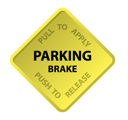Foundation brakes are the most common air brake systems in trucks and buses. They use a triple-valve principle which charges air into the tank, applying the brakes, and releasing them. Pressure increases in the cylinder while applying the brakes and in turn decreases pressure in the reservoir. The majority of the vehicles with air brakes have a graduated release system which allows a partial increase in pressure that delivers a proportional release in the brakes.
The components listed below make up a foundation air brake system in trucks and buses:
 Air compressor: Pumps the air into storage tanks
Air compressor: Pumps the air into storage tanks
Air compressor governor: Maintains a set amount of air in the tanks that is coming from the compressor
Reservoir tanks: Holds the pressurized air
Drain valves: Release valves that drain air from the tanks when the vehicle is not in use, keeping the tanks from over-pressurizing
Brake pedal: Essentially a valve that when it is depressed, air is released from the reservoir tanks
Brake chambers: A tube-shaped vessel which contains a slack adjuster that moves a cam or diaphragm device
Push rod: A steel rod that attaches the brake chamber to the slack adjuster. When extended the brakes are applied, if depressed the brakes release.
Slack adjusters: An arm which attaches the push rod to the brake s-cam for regulating the distance between the brake shoes
Brake S-Cam: An S-shaped cam that is a rotating or sliding piece in the mechanical linkage used to transform rotary motion into linear motion that pushes the brake shoes apart and presses against the brake drum
Brake shoe: The part of a braking system which carries the brake lining that creates friction against the brake drum
Return spring: A small rigid spring that is linked to each brake shoe which returns the shoe back to the open position when not depressed.
Push-to-Connect Fittings: D.O.T fittings that connect the air lines.
When the brakes are not depressed and the vehicle’s air system is charged, the air pressure keeps the s-cam or diaphragm in the closed position releasing pressure from the brake system. When the brake pedal is pushed down the air pressure is reduced which then turns the s-cam and spreads the brake shoes causing friction against the drum. The compressor then refills the reservoir tanks. When the pedal is allowed to retract, the air pressure increases back to its initial state.
 Emergency air brakes, or parking brakes, are a necessary counterpart to the air brake system which is activated by pulling a square yellow button on the dash. The button is pulled out when the vehicle is parked, especially on an incline. Before driving the vehicle, the emergency brake button must be pushed in to release the emergency brake and fill the system with air. The emergency brake will remain free if the emergency system is pressurized. If there is a leak in the system the pressure can decrease which can engage the emergency brake. Heavy trucks often have an exhaust brake that assists the braking process, yet is dependent on the engine, not the air brake system.
Emergency air brakes, or parking brakes, are a necessary counterpart to the air brake system which is activated by pulling a square yellow button on the dash. The button is pulled out when the vehicle is parked, especially on an incline. Before driving the vehicle, the emergency brake button must be pushed in to release the emergency brake and fill the system with air. The emergency brake will remain free if the emergency system is pressurized. If there is a leak in the system the pressure can decrease which can engage the emergency brake. Heavy trucks often have an exhaust brake that assists the braking process, yet is dependent on the engine, not the air brake system.

